The Davidsons visit Montana, 2023
My wife and her brothers have an interesting extended family. Their father -- named Harley Davidson! -- was born in Missouri, but moved to California during the depression to find work. He married a woman there, and had four children. The marriage foundered, and Harley moved back to Missouri, and married Mary Ann's mother, whom he had known before he went out west. Mary Ann and her three brothers were born between 1955 and 1961, but the family was always poor, and their mother died in 1970. Harley was not able to take care of the children, so they were raised by their aunts. Harley died in 1980. I met Mary Ann in 1982, so I never met either of her parents.
Mary Ann and her brother met their half-sister Myrna a couple times over the years, and in 2017 we all went out to California to stay with Myrna for a week. Their other half-sister Linda was there as well, but their half-brother Carl wasn't able to make it, because his wife Sandy had had a fall and couldn't travel. Myrna died a couple of years later. So as of this year, Mary Ann had never met her oldest half-brother. Carl lives in Montana, in Connor, a small town in the Bitterroot valley, not too far from the western border of Montana with Idaho, perhaps an hour south of Missoula. This year we made plans to visit Carl at his home -- Mary Ann and I; Mary Ann's brother Mark and his wife Becky; her brother Dwight and his wife Terrie, and her brother Scott, his daughter Rachel, and granddaughter Caitlyn.

Mary Ann and I left on Wednesday September 20, taking a flight to Salt Lake City. We wanted a nonstop flight, and to travel in easy stages to Connor. We stayed in Farmington, Utah, after a bit of an adventure with the rental car. (The first one didn't have working Bluetooth, so we had to return it, in the process meeting a guy who had moved to Salt Lake City just three weeks before -- from Lahaina, Maui. His house -- built by his great-grandfather (I think) in the late 1800s -- had just burned down) We chose Farmington because the hotels were cheaper and because it's reasonably close to Antelope Island, the largest island in the Great Salt Lake. (It is now only ambiguously an island, because the lake has lost so much water that you could, as of late last year, walk to land (though I imagine it would be a marshy walk.) It's got about 5 feet of depth back in the past few months, but needs about 7 or 8 more feet to be truly healthy.) Antelope Island is a Utah State Park. It's best known, I think, for its population of bison, which were imported in the late 19th century. We saw plenty of bison, but alas no pronghorn, which are native to the island. I was happy to visit the island, but it's not the most impressive natural place in the world, it's fair to say.

We then drove up to Idaho Falls, Idaho. September 21st is our anniversary (38 years!) and we had a nice steak dinner at a restaurant called Stockman's. There's not really that much more to see in Idaho Falls except the falls, and even they aren't all that spectacular. It was of interest to me because my Dad used to visit there regularly on business -- he worked at Argonne National Laboratory outside Chicago, and Idaho Falls is home to Idaho National Laboratory. (On the way we drove by Pocatello, home of Idaho State University, and of the first-rate SF/Fantasy scholar and editor, Brian Attebery. I did wave on the way back, Brian!)

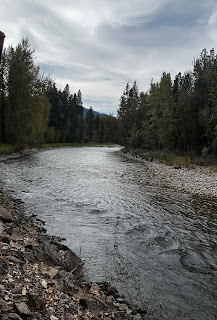
On Friday we went the rest of the way to Connor, and indeed to Hamilton, the somewhat larger city 30 or so miles from Connor where we had rented an Airbnb. This is in the Bitterroot Valley, between the Bitterroot mountains to the west (which pretty much form the border with Idaho) and the Sapphire Mountains to the east. The southern end dips slightly into Idaho, and the northern end bumps into Missoula. The Bitterroot River runs up the valley, which is around 4000 feet above sea level. The mountain peaks are over 10,000 feet. Lewis and Clark followed the Bitterroot River north in 1805. The primary Native American tribe was the Salish, though the Nez Perce lived nearby and in fact we drove by one of the more shameful battle (massacre) sites in American history, Big Hole, which is a bit east of the Sapphire mountains.

The area is currently modestly famous for being the key shooting location for the TV show Yellowstone. Indeed, the ranch from the show is just a couple miles north of Connor, and a shootout scene in one episode was filmed on Carl's street. The population of Ravalli County, which makes up most of the valley, is just over 40,000 people.
Our Airbnb was very nice. We had nine people staying, and five bedrooms, three baths, plus a "bonus room" over the garage with another bathroom, a large TV, a pingpong table and a pool table. There were two ponds on the property, and a pickleball court. There were elk and deer outside (and cows!) Lots of magpies, too, a bird I'd never really seen -- they are quite striking, black and white and fairly large.

Much of the next few days was occupied in visiting with Carl and other family members. Myrna's daughter Robin and her husband Keith, who are spending much of their retirement traveling the US in their RV, had arranged to be there. And Jimmy Garcia, a cousin, also lives in the Bitterroot valley. (He and Carl encountered each other in a bar many years ago, neither having any idea the other lived there.) Most of this was conversations, stories -- Carl telling about his life, and his brothers telling about theirs, comparing notes about their mutual father, etc. Some literal war stories. Stories about high school, about working life (Carl spent much of his career working on dredges), about hunting, so on. It was really striking, really moving, to see a family growing, expanding. And Carl is a damn good storyteller (so is Jimmy.)
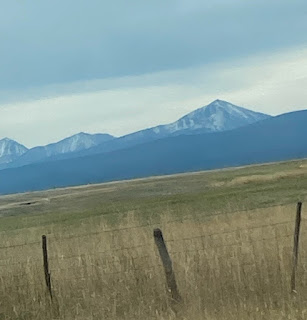
We shared dinners too. Caitlyn made soup for one dinner. Sandy and Carl cooked lunches and dinners. Becky and I did most of the breakfast cooking. We explored the valley some. One day driving down to Carl's we had to stop because the hay bales had fallen off a hay truck and blocked the highway. I got out with most of the other drivers and helped sweep the road. We went into Hamilton proper one day, did some shopping. The bookstore there, Chapter One, had a nice used book section where I bought some books (pictured at the bottom) -- the owner mentioned having visited St. Louis and in particular Left Bank Books. Another town, Darby, had some nice stores as well, including a candy shop and another used book store -- this one running on a book exchange model plus donations, no prices. One day we drove over to Wisdom, east of the Valley, about 45 minutes away (near the battle of Big Hole site) in search of highly recommended pizza. Alas, the place was closed -- the owner had fallen and wasn't in any condition to operate the restaurant. We also played pickleball, and fished (with no success) in the ponds. (Pickleball is exhausting!) And of course we luxuriated in the scenery -- it is really beautiful country.

By Tuesday it was time to head out. The goal was to get to Yellowstone. We were staying in Island Park, Idaho. We slept in a bit, did a final cleanup of the Airbnb, and left by 10 or so. The drive to Island Park took about 5 hours, with an only too interesting final stretch, over an extremely rough gravel road, followed by an even worse rutted dirt road. But at last we got there. It was just a bit too late to explore any of the park, so we just checked in. I did run up to West Yellowstone, the Montana town right outside the park, and went into a bookstore there (not that impressive a bookstore.)



Wednesday morning we did go to the park. We had a pleasant surprise entering it -- we are over 62, so we qualify for the senior discount, which is pretty good -- $20 gets you unlimited entrance to any National Park (or Monument) for a year, and $80 is good for the same for life. We realized pretty quickly that one day -- less than a full day -- isn't nearly enough to see the whole thing. We'll have to try to get back some time. What did we see? Some nice scenery -- the Madison River, in particular. And the Gibbons River, especially Gibbons Falls, which is pretty cool. (Apparently it's where the river cascades down into the caldera of the supervolcano.) I walked around the Norris Geyser area, with lots of fumaroles and such, and some geysers, none of which erupted. Pretty cool scenery, really, lots of strange colors and boiling mud and all that. I went by Steamboat Geyser, the tallest in the world. It erupts roughly every 30 to 40 days, and it had been 30-some days since the last eruption, so ... there was a chance? But no luck. I did chat for a bit with an Australian guy, there with his wife and two kids -- he said he was from Brisbane. I said I was "in the SF field" and one of my friends (Jonathan Strahan) lives in Perth (which of course is about as far from Brisbane as San Francisco from New York!) The guy said something like "I never knew there was an SF field!"


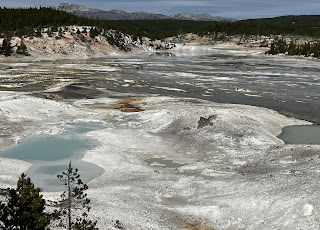


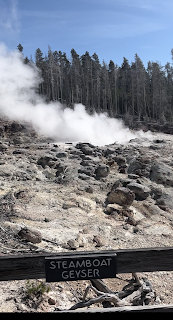
Those were a bit to the northwest of the Park, and then we headed south, to the Fountain Paint Pads -- more geysers and fumaroles and hot springs -- then to Old Faithful. We got there with about an hour to go before the predicted next eruption, so we grabbed some (very indifferent lunch) and then waited for the eruption. But Old Faithful was a bit of a strumpet, and didn't go off until a minute or so later than the latest time it was supposed to erupt. (That is, it was predicted to go at about 2:29, with a plus or minus 13 minute margin, and it went off at 2:43 ...) It's pretty impressive, I have to say. There were also bison wandering around, causing the park rangers to keep moving people away from them.

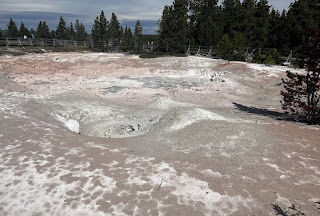

Then we checked the driving time to our hotel -- and we realized that we really had to leave pretty much right away. We had hoped to stop in at Grand Teton too -- and there just wasn't time, plus it would have made the drive longer to go south first, as we were staying in Farmington again. Really poor planning on our part. We probably should have stayed another day.
The trip back was mostly uneventful. Everything at the airport went smoothly, the flight was fine. And we got home to find -- a huge tree limb in the driveway! (Actually, a neighbor had warned us.)
It was really a wonderful vacation. Mostly for the family aspect, but also, Montana is a beautiful place, and Yellowstone is a treasure. We saw some fall changing colors, though not a lot -- we were probably a week early. If there was one mild disappointment, we didn't see quite as much cool wildlife as we hoped. Lots of deer, lots of bison. Only one pronghorn. No elk, no bears, no wolves. (Apparently there was a large crowd watching a grizzly bear eating an elk, but we missed that.) So we know the wild creatures are there -- but no luck for us. But that's not really a complaint -- we had a great time.


.jpg)






























